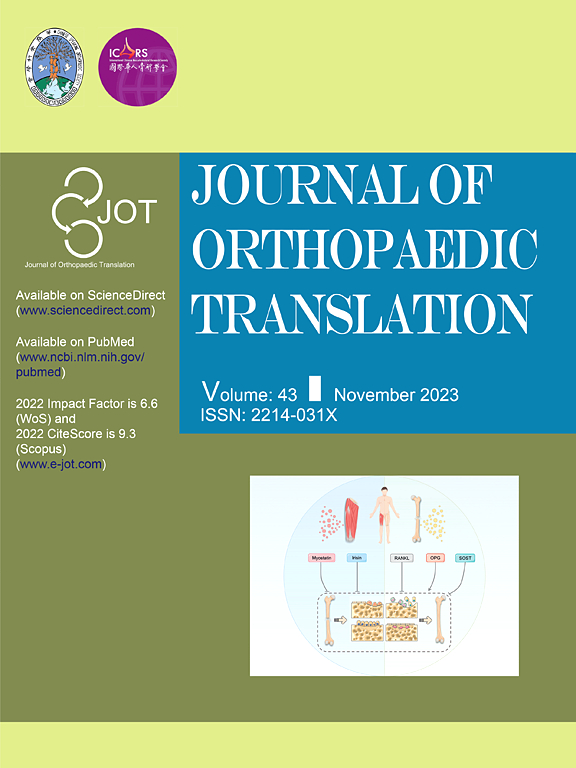RO5126766 attenuates osteoarthritis by inhibiting osteoclastogenesis and protecting chondrocytes through mediating the ERK pathway
IF 5.9
1区 医学
Q1 ORTHOPEDICS
引用次数: 0
Abstract
Background
Osteoarthritis (OA) is a degenerative joint disease that remains challenging to treat due to lack of complete understanding of its pathogenesis. Previous studies have identified RO5126766 (RO) as a small molecule compound that inhibited RAF/MEK-ERK pathway and garnered much interest for its anti-cancer properties. But its role in the treatment of OA remains unclear.
Methods
This study employed the anterior cruciate ligament transection (ACLT) procedure to create an OA model in mice. The effects of RO on pathological changes in articular cartilage and subchondral bone were assessed using micro-CT and histological staining. Mice received peritoneal injections of RO at 1 mg/kg and 5 mg/kg biweekly for 4 weeks after ACLT, while control mice received saline. In vitro, bone marrow-derived macrophages were cultured to examine the effects of RO on osteoclast activation using immunofluorescence, TRAP staining, and bone resorption assays. The inflammatory degeneration of chondrocytes and gene expression levels were evaluated using staining and RT-qPCR. Western blot and immunohistochemistry were used to analyze MAPK signaling and autophagy-related protein expression, investigating RO's molecular mechanism in OA treatment. Human single-cell data were also analyzed to identify genes and pathways upregulated in OA tissues.
Results
Our findings showed that RO protects subchondral bone by inhibiting osteoclast formation in the ACLT mouse model of OA. In vitro, RO was shown to inhibit osteoclast differentiation and reduce inflammatory degeneration of chondrocytes. Mechanistically, RO counteracted subchondral osteoclast hyperactivation by suppressing the ERK/c-fos/NFATc1 signaling pathway. Additionally, RO inhibited LPS-induced inflammatory degeneration of chondrocytes and enhanced autophagy via the ERK pathway. Single-cell analysis further confirmed significant upregulation of the ERK signaling pathway in human OA tissues.
Conclusions
Overall, our findings suggested that RO inhibited osteoclast differentiation and protected articular cartilage, suggesting its potential as a novel treatment for OA.
Translational potential of this article
In this study, we have, for the first time, substantiated the therapeutic potential of RO in the treatment of OA. By demonstrating its ability to inhibit osteoclast differentiation and protect articular cartilage, RO could offer a new avenue for disease-modifying treatments in OA. Thus, this paper provides valuable insights into understanding the molecular mechanisms and treatment of OA.

RO5126766通过介导ERK通路抑制破骨细胞发生,保护软骨细胞,从而减轻骨关节炎
骨关节炎(OA)是一种退行性关节疾病,由于缺乏对其发病机制的完整了解,治疗仍然具有挑战性。RO5126766 (RO)是一种抑制RAF/MEK-ERK通路的小分子化合物,其抗癌特性引起了人们的广泛关注。但其在OA治疗中的作用尚不清楚。方法采用前交叉韧带横断术(ACLT)建立小鼠骨关节炎模型。采用显微ct和组织学染色观察RO对关节软骨和软骨下骨病理变化的影响。ACLT后,小鼠每两周腹腔注射1 mg/kg和5 mg/kg的RO,对照组小鼠注射生理盐水。体外培养骨髓源性巨噬细胞,采用免疫荧光法、TRAP染色法和骨吸收法检测RO对破骨细胞活化的影响。采用染色法和RT-qPCR检测软骨细胞炎性变性及基因表达水平。Western blot和免疫组织化学分析MAPK信号和自噬相关蛋白的表达,探讨RO在OA治疗中的分子机制。还分析了人类单细胞数据,以确定OA组织中上调的基因和途径。结果在骨性关节炎ACLT小鼠模型中,RO通过抑制破骨细胞形成来保护软骨下骨。在体外,RO被证明可以抑制破骨细胞的分化,减少软骨细胞的炎症变性。在机制上,RO通过抑制ERK/c-fos/NFATc1信号通路来抵消软骨下破骨细胞的过度活化。此外,RO通过ERK途径抑制lps诱导的软骨细胞炎症变性和增强自噬。单细胞分析进一步证实了人OA组织中ERK信号通路的显著上调。结论总的来说,我们的研究结果表明,RO抑制破骨细胞分化并保护关节软骨,这表明它有可能成为OA的一种新型治疗方法。在这项研究中,我们首次证实了RO在OA治疗中的治疗潜力。通过证明其抑制破骨细胞分化和保护关节软骨的能力,RO可能为OA的疾病改善治疗提供新的途径。因此,本文为了解OA的分子机制和治疗提供了有价值的见解。
本文章由计算机程序翻译,如有差异,请以英文原文为准。
求助全文
约1分钟内获得全文
求助全文
来源期刊

Journal of Orthopaedic Translation
Medicine-Orthopedics and Sports Medicine
CiteScore
11.80
自引率
13.60%
发文量
91
审稿时长
29 days
期刊介绍:
The Journal of Orthopaedic Translation (JOT) is the official peer-reviewed, open access journal of the Chinese Speaking Orthopaedic Society (CSOS) and the International Chinese Musculoskeletal Research Society (ICMRS). It is published quarterly, in January, April, July and October, by Elsevier.
 求助内容:
求助内容: 应助结果提醒方式:
应助结果提醒方式:


